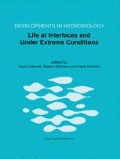Abstract
During the field surveys in the Bothnian Sea, i.e. towards low salinity areas (approx. 4%), present authors observed that the frequency of irregularly branched Fucus vesiculosus plants increased. Salinity is known to decrease gradually towards the northern parts of the Baltic Sea. However, salinity is not steady but may fluctuate greatly on an annual and even a daily scale, and salinity can drop to zero for short periods. In order to demonstrate whether the fluctuating salinity induces irregular branching of F vesiculosusus, a experiment was carried out in the Tvärminne archipelago, on the south coast of Finland in May-September 1997. First, plants were collected and then put into two containers both of which had a fresh water and a sea water flow throught. After 48 h of treatment, the plants were removed to the same place where they had been orginally collected. After the growing season, the plants were collected again, and the number of irregularly and normally branched tips were measured. The results shows that plants with the fresh water treatment have branched irregularly. In constrast, the control plants had only a few irregularly branched tips. This experiment brings us to conclude that low salinity during the critical growing season induces irregular branching.
Access this chapter
Tax calculation will be finalised at checkout
Purchases are for personal use only
Preview
Unable to display preview. Download preview PDF.
References
Bäck, S., J.C. Collins & G. Russell, 1991. Aspects of reproductive biology of Fucus vesiculosus from the coast of SW Finland. Ophelia 34: 129–141.
Bäck, S., 1993. Morphological variation of the northern Baltic Fucus vesiculosus along the exposure gradient. Ann. bot. fenn. 30: 275–283.
Haapala, J. & P. Alenius, 1994. Temperature and salinity statistics for the Northern Baltic Sea 1961-1991. Finnish Mar. Res. 262: 51–121.
Kiirikki, M. & A. Ruuskanen, 1996. How does Fucus vesiculosus survive ice scraping? Bot. Mar. 39: 133–139.
Luther, H., 1981. Occurrence and ecological requirements of Fucus vesiculosus in semi-enclosed inlets of the Archipelago Sea, SW Finland. Ann. bot. fenn. 18: 187–200.
Moss, B., 1964. Apical dominance in Fucus vesiculosus. New Phytol. 64: 387–392.
Raven, J.A. & G. Samuelsson, 1988. Ecophysiology of Fucus vesiculosus L. close to its northern limit in the Gulf of Bothnia. Bot. mar. 31: 399–410.
Rönnberg, O. & I. Haahtela, 1988. Does anchor ice contribute to the decline of Fucus in the Baltic? Mar. Poll. Bull. 19: 388–389.
Serrão, E.A., L. Kautsky & S.H. Brawley, 1996. Distributional success of the marine seaweed Fucus vesiculosus L. in the brackish Baltic Sea correlates with osmotic capabilities of Baltic gametes. Oecologia 107: 1–12.
Author information
Authors and Affiliations
Corresponding author
Editor information
Rights and permissions
Copyright information
© 2000 Springer Science+Business Media Dordrecht
About this paper
Cite this paper
Ruuskanen, A., Kiirikki, M. (2000). Does fluctuating salinity induce branching of Fucus vesiculosus?. In: Liebezeit, G., Dittmann, S., Kröncke, I. (eds) Life at Interfaces and Under Extreme Conditions. Developments in Hydrobiology, vol 151. Springer, Dordrecht. https://doi.org/10.1007/978-94-011-4148-2_16
Download citation
DOI: https://doi.org/10.1007/978-94-011-4148-2_16
Publisher Name: Springer, Dordrecht
Print ISBN: 978-94-010-5808-7
Online ISBN: 978-94-011-4148-2
eBook Packages: Springer Book Archive

